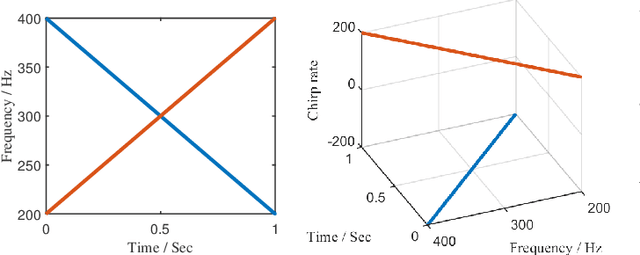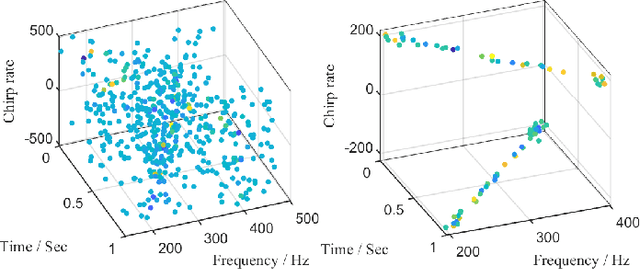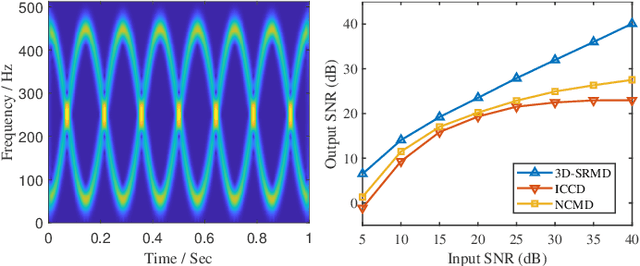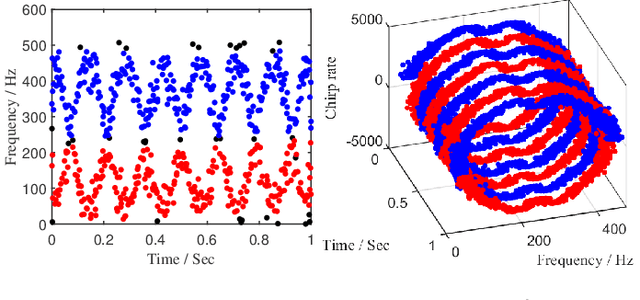Chen Luo
School of Mathematical Science, Inner Mongolia University, Hohhot, China
Towards Globally Predictable k-Space Interpolation: A White-box Transformer Approach
Aug 06, 2025Abstract:Interpolating missing data in k-space is essential for accelerating imaging. However, existing methods, including convolutional neural network-based deep learning, primarily exploit local predictability while overlooking the inherent global dependencies in k-space. Recently, Transformers have demonstrated remarkable success in natural language processing and image analysis due to their ability to capture long-range dependencies. This inspires the use of Transformers for k-space interpolation to better exploit its global structure. However, their lack of interpretability raises concerns regarding the reliability of interpolated data. To address this limitation, we propose GPI-WT, a white-box Transformer framework based on Globally Predictable Interpolation (GPI) for k-space. Specifically, we formulate GPI from the perspective of annihilation as a novel k-space structured low-rank (SLR) model. The global annihilation filters in the SLR model are treated as learnable parameters, and the subgradients of the SLR model naturally induce a learnable attention mechanism. By unfolding the subgradient-based optimization algorithm of SLR into a cascaded network, we construct the first white-box Transformer specifically designed for accelerated MRI. Experimental results demonstrate that the proposed method significantly outperforms state-of-the-art approaches in k-space interpolation accuracy while providing superior interpretability.
SessionIntentBench: A Multi-task Inter-session Intention-shift Modeling Benchmark for E-commerce Customer Behavior Understanding
Jul 27, 2025Abstract:Session history is a common way of recording user interacting behaviors throughout a browsing activity with multiple products. For example, if an user clicks a product webpage and then leaves, it might because there are certain features that don't satisfy the user, which serve as an important indicator of on-the-spot user preferences. However, all prior works fail to capture and model customer intention effectively because insufficient information exploitation and only apparent information like descriptions and titles are used. There is also a lack of data and corresponding benchmark for explicitly modeling intention in E-commerce product purchase sessions. To address these issues, we introduce the concept of an intention tree and propose a dataset curation pipeline. Together, we construct a sibling multimodal benchmark, SessionIntentBench, that evaluates L(V)LMs' capability on understanding inter-session intention shift with four subtasks. With 1,952,177 intention entries, 1,132,145 session intention trajectories, and 13,003,664 available tasks mined using 10,905 sessions, we provide a scalable way to exploit the existing session data for customer intention understanding. We conduct human annotations to collect ground-truth label for a subset of collected data to form an evaluation gold set. Extensive experiments on the annotated data further confirm that current L(V)LMs fail to capture and utilize the intention across the complex session setting. Further analysis show injecting intention enhances LLMs' performances.
Bradley-Terry and Multi-Objective Reward Modeling Are Complementary
Jul 10, 2025Abstract:Reward models trained on human preference data have demonstrated strong effectiveness in aligning Large Language Models (LLMs) with human intent under the framework of Reinforcement Learning from Human Feedback (RLHF). However, RLHF remains vulnerable to reward hacking, where the policy exploits imperfections in the reward function rather than genuinely learning the intended behavior. Although significant efforts have been made to mitigate reward hacking, they predominantly focus on and evaluate in-distribution scenarios, where the training and testing data for the reward model share the same distribution. In this paper, we empirically show that state-of-the-art methods struggle in more challenging out-of-distribution (OOD) settings. We further demonstrate that incorporating fine-grained multi-attribute scores helps address this challenge. However, the limited availability of high-quality data often leads to weak performance of multi-objective reward functions, which can negatively impact overall performance and become the bottleneck. To address this issue, we propose a unified reward modeling framework that jointly trains Bradley--Terry (BT) single-objective and multi-objective regression-based reward functions using a shared embedding space. We theoretically establish a connection between the BT loss and the regression objective and highlight their complementary benefits. Specifically, the regression task enhances the single-objective reward function's ability to mitigate reward hacking in challenging OOD settings, while BT-based training improves the scoring capability of the multi-objective reward function, enabling a 7B model to outperform a 70B baseline. Extensive experimental results demonstrate that our framework significantly improves both the robustness and the scoring performance of reward models.
EcomScriptBench: A Multi-task Benchmark for E-commerce Script Planning via Step-wise Intention-Driven Product Association
May 21, 2025Abstract:Goal-oriented script planning, or the ability to devise coherent sequences of actions toward specific goals, is commonly employed by humans to plan for typical activities. In e-commerce, customers increasingly seek LLM-based assistants to generate scripts and recommend products at each step, thereby facilitating convenient and efficient shopping experiences. However, this capability remains underexplored due to several challenges, including the inability of LLMs to simultaneously conduct script planning and product retrieval, difficulties in matching products caused by semantic discrepancies between planned actions and search queries, and a lack of methods and benchmark data for evaluation. In this paper, we step forward by formally defining the task of E-commerce Script Planning (EcomScript) as three sequential subtasks. We propose a novel framework that enables the scalable generation of product-enriched scripts by associating products with each step based on the semantic similarity between the actions and their purchase intentions. By applying our framework to real-world e-commerce data, we construct the very first large-scale EcomScript dataset, EcomScriptBench, which includes 605,229 scripts sourced from 2.4 million products. Human annotations are then conducted to provide gold labels for a sampled subset, forming an evaluation benchmark. Extensive experiments reveal that current (L)LMs face significant challenges with EcomScript tasks, even after fine-tuning, while injecting product purchase intentions improves their performance.
Cite Before You Speak: Enhancing Context-Response Grounding in E-commerce Conversational LLM-Agents
Mar 05, 2025Abstract:With the advancement of conversational large language models (LLMs), several LLM-based Conversational Shopping Agents (CSA) have been developed to help customers answer questions and smooth their shopping journey in e-commerce domain. The primary objective in building a trustworthy CSA is to ensure the agent's responses are accurate and factually grounded, which is essential for building customer trust and encouraging continuous engagement. However, two challenges remain. First, LLMs produce hallucinated or unsupported claims. Such inaccuracies risk spreading misinformation and diminishing customer trust. Second, without providing knowledge source attribution in CSA response, customers struggle to verify LLM-generated information. To address these challenges, we present an easily productionized solution that enables a "citation experience" utilizing In-context Learning (ICL) and Multi-UX-Inference (MUI) to generate responses with citations to attribute its original sources without interfering other existing UX features. With proper UX design, these citation marks can be linked to the related product information and display the source to our customers. In this work, we also build auto-metrics and scalable benchmarks to holistically evaluate LLM's grounding and attribution capabilities. Our experiments demonstrate that incorporating this citation generation paradigm can substantially enhance the grounding of LLM responses by 13.83% on the real-world data. As such, our solution not only addresses the immediate challenges of LLM grounding issues but also adds transparency to conversational AI.
How Far are LLMs from Real Search? A Comprehensive Study on Efficiency, Completeness, and Inherent Capabilities
Feb 26, 2025Abstract:Search plays a fundamental role in problem-solving across various domains, with most real-world decision-making problems being solvable through systematic search. Drawing inspiration from recent discussions on search and learning, we systematically explore the complementary relationship between search and Large Language Models (LLMs) from three perspectives. First, we analyze how learning can enhance search efficiency and propose Search via Learning (SeaL), a framework that leverages LLMs for effective and efficient search. Second, we further extend SeaL to SeaL-C to ensure rigorous completeness during search. Our evaluation across three real-world planning tasks demonstrates that SeaL achieves near-perfect accuracy while reducing search spaces by up to 99.1% compared to traditional approaches. Finally, we explore how far LLMs are from real search by investigating whether they can develop search capabilities independently. Our analysis reveals that while current LLMs struggle with efficient search in complex problems, incorporating systematic search strategies significantly enhances their problem-solving capabilities. These findings not only validate the effectiveness of our approach but also highlight the need for improving LLMs' search abilities for real-world applications.
Stepwise Perplexity-Guided Refinement for Efficient Chain-of-Thought Reasoning in Large Language Models
Feb 18, 2025Abstract:Chain-of-Thought (CoT) reasoning, which breaks down complex tasks into intermediate reasoning steps, has significantly enhanced the performance of large language models (LLMs) on challenging tasks. However, the detailed reasoning process in CoT often incurs long generation times and high computational costs, partly due to the inclusion of unnecessary steps. To address this, we propose a method to identify critical reasoning steps using perplexity as a measure of their importance: a step is deemed critical if its removal causes a significant increase in perplexity. Our method enables models to focus solely on generating these critical steps. This can be achieved through two approaches: refining demonstration examples in few-shot CoT or fine-tuning the model using selected examples that include only critical steps. Comprehensive experiments validate the effectiveness of our method, which achieves a better balance between the reasoning accuracy and efficiency of CoT.
Three-Dimensional Sparse Random Mode Decomposition for Mode Disentangling with Crossover Instantaneous Frequencies
Jan 25, 2025



Abstract:Sparse random mode decomposition (SRMD) is a novel algorithm that constructs a random time-frequency feature space to sparsely approximate spectrograms, effectively separating modes. However, it fails to distinguish adjacent or overlapped frequency components, especially, those with crossover instantaneous frequencies. To address this limitation, an enhanced version, termed three-dimensional SRMD (3D-SRMD), is proposed in this letter. In 3D-SRMD, the random features are lifted from a two-dimensional space to a three-dimensional (3D) space by introducing one extra chirp rate axis. This enhancement effectively disentangles the frequency components overlapped in the low dimension. Additionally, a novel random feature generation strategy is designed to improve the separation accuracy of 3D-SRMD by combining the 3D ridge detection method. Finally, numerical experiments on both simulated and real-world signals demonstrate the effectiveness of our method.
Reasoning with Graphs: Structuring Implicit Knowledge to Enhance LLMs Reasoning
Jan 14, 2025Abstract:Large language models (LLMs) have demonstrated remarkable success across a wide range of tasks; however, they still encounter challenges in reasoning tasks that require understanding and inferring relationships between distinct pieces of information within text sequences. This challenge is particularly pronounced in tasks involving multi-step processes, such as logical reasoning and multi-hop question answering, where understanding implicit relationships between entities and leveraging multi-hop connections in the given context are crucial. Graphs, as fundamental data structures, explicitly represent pairwise relationships between entities, thereby offering the potential to enhance LLMs' reasoning capabilities. External graphs have proven effective in supporting LLMs across multiple tasks. However, in many reasoning tasks, no pre-existing graph structure is provided. Can we structure implicit knowledge derived from context into graphs to assist LLMs in reasoning? In this paper, we propose Reasoning with Graphs (RwG) by first constructing explicit graphs from the context and then leveraging these graphs to enhance LLM reasoning performance on reasoning tasks. Extensive experiments demonstrate the effectiveness of the proposed method in improving both logical reasoning and multi-hop question answering tasks.
A Survey of Calibration Process for Black-Box LLMs
Dec 17, 2024



Abstract:Large Language Models (LLMs) demonstrate remarkable performance in semantic understanding and generation, yet accurately assessing their output reliability remains a significant challenge. While numerous studies have explored calibration techniques, they primarily focus on White-Box LLMs with accessible parameters. Black-Box LLMs, despite their superior performance, pose heightened requirements for calibration techniques due to their API-only interaction constraints. Although recent researches have achieved breakthroughs in black-box LLMs calibration, a systematic survey of these methodologies is still lacking. To bridge this gap, we presents the first comprehensive survey on calibration techniques for black-box LLMs. We first define the Calibration Process of LLMs as comprising two interrelated key steps: Confidence Estimation and Calibration. Second, we conduct a systematic review of applicable methods within black-box settings, and provide insights on the unique challenges and connections in implementing these key steps. Furthermore, we explore typical applications of Calibration Process in black-box LLMs and outline promising future research directions, providing new perspectives for enhancing reliability and human-machine alignment. This is our GitHub link: https://github.com/LiangruXie/Calibration-Process-in-Black-Box-LLMs
 Add to Chrome
Add to Chrome Add to Firefox
Add to Firefox Add to Edge
Add to Edge